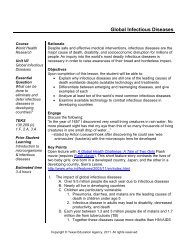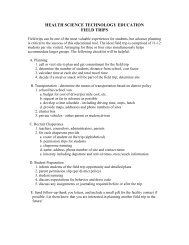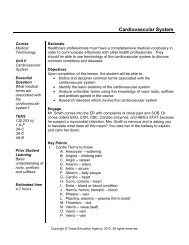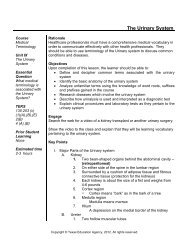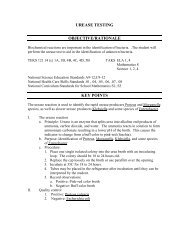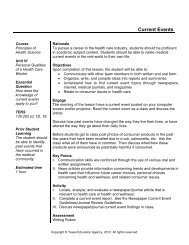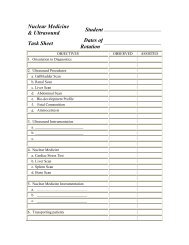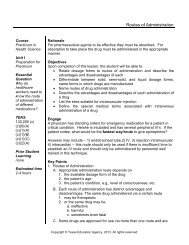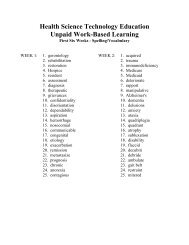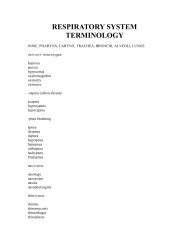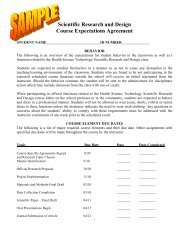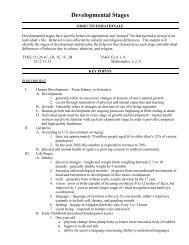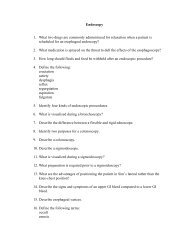SCIENTIFIC METHOD
SCIENTIFIC METHOD
SCIENTIFIC METHOD
Create successful ePaper yourself
Turn your PDF publications into a flip-book with our unique Google optimized e-Paper software.
<strong>SCIENTIFIC</strong> <strong>METHOD</strong><br />
OBJECTIVES/RATIONAL<br />
In research, the scientific method is used to acquire dependable information when solving<br />
problems, making responsible choices, and evaluating the impact of new discoveries on society.<br />
Students will apply the systemic approach of the scientific method to investigate and gain a<br />
better understanding of the problem<br />
TEKS: 121.12 1A, 1B, 2A, 2B, 2C, 2D, 3A, 3B, 3C, 4B, 8A, 8B, 8C, 9B<br />
TAKS ELA 1, 3, 4, 6<br />
Mathematics 1, 10<br />
Science 1<br />
KEY POINTS<br />
The scientific method is characterized by (1) order (2) control (3) empiricism (4) generalization<br />
and theoretical formulation.<br />
The scientific approach to problem solving requires the application of order and discipline to<br />
instill confidence in the investigator’s results. This requires the application of the scientific<br />
method, in which a series of systematic steps are followed to solve problems. It can be tested and<br />
the steps may be deleted, skipped or the order may vary. The steps may include the following:<br />
(1) identification of the problem to be investigated<br />
(2) review of existing literature and information concerning the problem<br />
(3) formation of the hypothesis (Null and Alternate)/statement of purpose of study<br />
(4) designing the experiment<br />
(5) collection of data<br />
(6) analyzing the data<br />
(7) drawing conclusions<br />
(8) replicating the investigation<br />
(9) dissemination of results *Research is useless without this step<br />
I<br />
IDENTIFY THE PROBLEM<br />
The study should start with a research question that addresses what the researcher would<br />
like to know. The goal is to find an important one that is feasible. The research question,<br />
which the researcher will answer, is selected and refined into a problem statement. The<br />
problem must be researchable and able to be tested. The research should contribute new<br />
knowledge about the problem. Consideration must be given to the availability of methods<br />
to investigate the problem, the availability of participants/subjects for the study,<br />
constraints of time and money required for the study, as well as ethical implications of<br />
the research project.<br />
Research questions often begin with a vague and general statement which must be<br />
narrowed down to a concrete, focused issue before the planning efforts begin. This may<br />
involve breaking down the original question into smaller parts and choosing a smaller<br />
portion of the original question to build a study around. Research question should be<br />
“FINER”: feasible, interesting, novel, ethical, and relevant.
II<br />
REVIEW THE LITERATURE<br />
To place the problem in the context of what is already known about the problem, the<br />
researcher reviews the scientific literature related to the problem, citing references to<br />
professional publications and journal articles which pertain to the problem.<br />
The literature review will summarize the existing knowledge pertaining to the problem<br />
and will help the researcher learn more about the problem. The researcher then uses this<br />
information to predict the outcome of the research or formulate a hypothesis.<br />
Significance<br />
A good research question should pass the “so what” test. The answer should contribute to<br />
the present knowledge about the topic. This gives the study rationale. What is presently<br />
known about the topic, why is the research question important, and what type of answer<br />
might the research study provide? The researcher will cite existing research that is<br />
relevant and indicate the possible problems with that research and what question(s)<br />
remain. The researcher makes clear how the results of the study will resolve these<br />
uncertainties. The student may also find a study to replicate or a well-written study to use<br />
as a guide.<br />
III<br />
FORM THE HYPOTHESIS<br />
The hypothesis is the statement of the purpose of the study. Hypotheses are statements<br />
that predict a relationship between two or more variables that can be tested. The<br />
hypothesis may be stated as a NULL HYPOTHESIS: a statement which indicates that<br />
there is no difference between two groups after treatment or as an ALTERNATE<br />
HYPOTHESIS: a statement which indicates there is a difference between two groups<br />
after treatment or both.<br />
Example of a null hypothesis: Children of handicapped parents perceive their<br />
body image the same way that children of non-handicapped parents do.<br />
Example of an alternative hypothesis: Children of handicapped parents<br />
perceive their body image differently than children of non-handicapped<br />
parents.<br />
Variables are concepts that are defined in a way so that variations may be observed and<br />
measured. Variables may be classified as several ways: independent variables, dependent<br />
variables, and controlled variables.<br />
Independent Variables: The treatment or condition that is expected to<br />
produce the result or outcome. On a graph, the independent variable is<br />
placed on the horizontal axis.
Dependent Variable: The result or outcome that is expected to occur from a<br />
treatment. The change in the dependent variable is presumed to be caused by<br />
the independent variable. The dependent variable is observed, measured, and<br />
analyzed to detect changes caused by the independent variable. On a graph,<br />
the dependent variable is placed on the vertical axis.<br />
Control Variable: The characteristic that is controlled by the researcher in<br />
order to reduce any impact this factor might have on the interpretation of the<br />
results. Controlled variables should not be allowed to change. Controlled<br />
variables are not shown on a graph.<br />
Moderator Variable: A characteristic that influences the impact of the<br />
independent variable upon the dependent variable.<br />
Extraneous Variable: Factors that produce uncontrolled, unpredictable<br />
impacts on the dependent variable. Extraneous variables may cause<br />
confusion if they are not controlled. They are contaminating factors that are<br />
a threat to the validity of the study.<br />
Control of factors not relevant to the investigation is an essential element of<br />
the scientific method. The investigator must try to identify the factors and<br />
the effects of the factors not directly investigated in connection with the<br />
problem, and try to keep them from influencing factors identified in the<br />
study.<br />
IV<br />
DESIGN THE EXPERIMENT<br />
The experimental design defines the way that pertinent information will be gathered in<br />
order to answer the research question.<br />
A. HISTORICAL – constructs the past in relation to the hypothesis<br />
Tracing the history of anesthesia in the USA<br />
B. QUANTITATIVE DESCRIPTIVE – systematically describes an area of interest<br />
Uses strategies such as questionnaires or observational techniques to collect<br />
information about the characteristics of a person, group, or program.<br />
Surveys, census studies.<br />
C. DEVELOPMENTAL – investigates patterns and sequences as a function of time<br />
Longitudinal study of a group over a number of years or a cross-sectional study<br />
investigating changing patterns by sampling groups at different ages or levels.<br />
D. CASE AND FIELD – studies the background, current status, and environmental<br />
interactions of a given social unit (an individual group…..)<br />
Case histories of a group of teens on probation for drug abuse
E. CORRELATIONAL – investigates the extent to which variations in factor<br />
correspond with variations in other factors<br />
Study of student success in college based on patterns between college grades and<br />
selected high school variables<br />
F. CASUAL-COMPARATIVE – investigated cause and effect relationships by<br />
observing an existing consequence and looking back through data for a possible<br />
cause.<br />
Identify factors related to high school drop-out rates using data from records over<br />
the past en years<br />
G. TRUE EXPERIMENTAL – investigates cause and effect relationships by<br />
exposing one or more experimental groups to one or more treatments and<br />
comparing the results to control groups not receiving the treatment (must be<br />
random). Investigate the effectiveness of three different teaching methods to first<br />
grade students using random assignments of students and teachers<br />
H. QUASI – EXPERIMENTAL – approximates the true experimental in a limited<br />
setting. Researcher must understand thoroughly the compromises which exist that<br />
may affect the internal and external validity of the design<br />
Attempt to get factors where only partial control is possible<br />
I. ACTION – develops new skills or new approaches or solves problems with direct<br />
application to a setting<br />
In-service training program to help teachers develop new skills in facilitating<br />
class discussions<br />
All of the terms relating to the study must be carefully defined so there is no question<br />
about what the researcher means. The methodology defines the way that information or<br />
data will be gathered in order to answer the research question or hypothesis. This<br />
includes details about the selection of subjects who will participate in the study, and<br />
description of the data collection procedures and techniques. Plans for analysis of the data<br />
should also be included. Limitations of the study are included to identify particular<br />
aspects of the study over which the researcher has no control.<br />
The scientific process is usually considered to be the highest form of human knowledge.<br />
Questions involving morality, complex social and psychological phenomena are hard to<br />
investigate because of the problems involved in measuring. When the study requires<br />
human subjects, constraints to protect them often pose added restrictions. It is vitally<br />
important that the investigator assures the protection of the rights of the study subjects as<br />
well as conform to the policies and procedures of the institution they are associated with.<br />
V. COLLECT DATA<br />
Record data, information, observations, and measurements accurately in a logbook. This<br />
step is necessary for reproducibility and to adequately test the hypothesis. Measurements<br />
should be accurate and precise. Information and data should be relevant to the stated<br />
research problem and recorded on tables, flow charts, concept maps, as notes, drawings,<br />
or diagrams.
VI.<br />
VII.<br />
ANALYZE THE DATA<br />
Analyze the data through graphs (bar, line, pie or circle) and statistics to determine<br />
relationships between variables and to find sources of error. The scientific method is also<br />
characterized by empiricism. The evidence gathered to generate new knowledge must be<br />
rooted in objective reality and must have been gathered through the human senses<br />
directly or indirectly.<br />
DRAW CONCLUSIONS<br />
The conclusion should be based on the experiment and address the hypothesis. It should<br />
be VALID (based on the evidence) and RELIABLE (repeatable). The conclusion may<br />
either accept the hypothesis or reject the hypothesis. It is perfectly acceptable to reject the<br />
hypothesis. Many times scientists will have to reject their hypothesis based on the data<br />
they have collected and analyzed.<br />
The scientific method is characterized by generalization. This means that the investigator<br />
does not use the scientific method merely to understand isolated events but must also be<br />
able to apply the results to a broader setting. The kinds of generalizations that result often<br />
assist in the development of new scientific theories and provide explanations and<br />
predictions of future events.<br />
VIII. REPLICATE THE STUDY – either multiple trials or multiple set-ups<br />
IX.<br />
DISSEMINATE THE RESULTS<br />
After analyzing the data in relation to the research problem, the researcher will formulate<br />
conclusions, discuss them, and relate these conclusions to relevant present knowledge.<br />
The researcher will also cite implications of the research and suggest areas for further<br />
study. The researcher will target an audience who will benefit from the information the<br />
study offers. Taking into consideration the needs of the audience, the researcher will<br />
communicate the study as clearly as possible by submitting a paper to a suitable<br />
professional journal and/or presenting the results of the study at a professional<br />
conference. Without the dissemination of results – research has no useful purpose!<br />
http://www.visionlearning.com/myclassroom/courses/NSC107_Carpi_index.htm<br />
• Choose: 1-Scient. Method<br />
http://phyun5.ucr.edu/~wudka/Physics7/Notes_www/node5.html<br />
http://pc65.frontier.osrhe.edu/hs/science/pmethod.htm<br />
http://www.visionlearning.com/myclassroom/courses/NSC107_Carpi_index.htm<br />
ACTIVITIES<br />
Students will design a problem that can be tested by the scientific method. Students will explain<br />
each step of the scientific method as it pertains to the imaginary research problem and orally<br />
present their work to the class for peer critique.<br />
Example: Using each step of the scientific method, describe what should be done to determine if<br />
a particular drug (DM2001) inhibits the reproduction of the deadly Bacteria S18. Identify all<br />
variables. Communicate the hypothesis and project design to the rest of the class for peer<br />
evaluation of the use of the scientific method, variable identification, and design. State how you
would determine whether the new drug would be a good choice for therapy and what impact its<br />
use may have on society.<br />
MATERIALS NEEDED<br />
Common Mistakes Made By Beginning Researchers Handout<br />
ASSESSMENT<br />
Scientific Method Rubric-Critique Form<br />
Instructions for Scientific Method Rubric-Critique Form<br />
Scientific Method Self-Evaluation Form<br />
REFLECTIONS<br />
Teacher note: Encourage students to combine their research project with science fair, physics<br />
projects, and/or technical writing assignments.
COMMON MISTAKES MADE BY BEGINNING RESEARCHERS<br />
1. Puts off selection of a problem until all or most of course work has been<br />
finished.<br />
2. Accepts the first research idea that is thought of or suggested.<br />
3. Selects a problem that is too vast or too vague to investigate meaningfully.<br />
(poorly designed).<br />
4. Prepares a hypothesis that is not testable.<br />
5. Fails to consider methods or analytical procedures in developing a tentative<br />
research plan.<br />
6. Carries out a hurried literature review in order to get started on the<br />
research project.<br />
7. Fails to thoroughly evaluate the instruments available for data collection before<br />
selecting those to be used in the research. This often leads to the use of invalid or<br />
inappropriate methods.<br />
8. Collects research data, then tries to find a statistical technique that can be used in<br />
the analysis.<br />
9. Selects a statistical tool that is inappropriate for the proposed analysis.<br />
10. Fails to define the research target population.<br />
11. Attempts to carry out a study in a few months that would require 2-3 years to do<br />
satisfactorily.<br />
12. Uses a sample that is too small to permit proper analysis of interesting subgroups.<br />
13. Attempts to conduct research using volunteer subjects only.<br />
14. Changes the experimental design in ways that weakens the research in order to make the<br />
data collection more convenient.<br />
15. Asks too many questions, making unreasonable demands on the respondent’s time.<br />
Source: Handbook In Research and Evaluation by Stephen Isaac and William Michael
<strong>SCIENTIFIC</strong> <strong>METHOD</strong> CRITIQUE FORM<br />
STUDENT’S NAME: _______________________________Date: _________________<br />
Possible<br />
Criteria<br />
Points<br />
1 Accurately stated the problem 5<br />
2 Adequate background research 15<br />
3 Testable hypothesis 10<br />
4 Clearly described experiment design 20<br />
5 Described control group 10<br />
6 Adequately identified experimental group 10<br />
7 Data collection relevant to project 10<br />
8 Demonstrated repetition 10<br />
9 Stated conclusion based on data and<br />
relevant to hypothesis<br />
10<br />
TOTAL POINTS 100<br />
Points<br />
Received<br />
Most outstanding quality:<br />
________________________________________________________________________<br />
________________________________________________________________________<br />
Suggestions for improvement:<br />
________________________________________________________________________<br />
Evaluator’s signature: _____________________________________________________
EXPLANATION OF <strong>SCIENTIFIC</strong> <strong>METHOD</strong> RUBRIC<br />
1 Accurately stated the problem 5<br />
2 Adequate background research 15<br />
3 Testable hypothesis 10<br />
4 Clearly described experiment design 20<br />
5 Described control group 10<br />
6 Adequately identified experimental group 10<br />
7 Data collection relevant to project 10<br />
8 Demonstrated repetition 10<br />
9 Stated conclusion based on data and<br />
relevant to hypothesis<br />
1. STATE THE PROBLEM: The problem is usually stated as a question to be<br />
solved. It MUST be testable! (5 points maximum)<br />
2. BACKGROUND RESEARCH / LITERATURE REVIEW: Evidence of<br />
background research must be presented. This may include library research of<br />
professional journals concerning the topic. (15 points maximum)<br />
3. A TESTABLE HYPOTHESIS: The hypothesis MUST be testable. The student<br />
may state a null hypothesis, an alternative hypothesis, or both.<br />
(10 points maximum)<br />
4. DESCRIBE THE EXPERIMENT: The student must include all factors that<br />
may affect the results of the experiment, including independent variables,<br />
dependent variables, and control variables. (20 points maximum)<br />
5. DESCRIBE THE CONTROL GROUP: A control variable – kept the same in both<br />
groups - must be included, identified, and described. (10 points maximum)<br />
6. DESCRIBE THE EXPERIMENTAL GROUP: The student must identify the<br />
experimental group – the one composed of the independent variable.<br />
(10 points maximum)<br />
7. DESCRIBE RELEVANT COLLECTIBLE DATA: Student will describe data to<br />
be collected. Describe graph(s) or charts that would be appropriate.<br />
(10 points maximum)<br />
8. DEMONSTRATE REPETITION: The student must describe either multiple trials<br />
or multiple experimental setups. (10 points maximum)<br />
9. STATE A CONCLUSION BASED ON THE DATA: The conclusion MUST be<br />
based on the collected data. The conclusion should either support or reject the<br />
stated hypothesis. Rejection of the hypothesis is perfectly acceptable. Researchers<br />
often must reject their hypotheses. (10 points maximum)<br />
10
<strong>SCIENTIFIC</strong> <strong>METHOD</strong> SELF-EVALUATION FORM<br />
STUDENT’S NAME: _____________________________________________________<br />
Criteria<br />
Possible<br />
Points<br />
Accurately stated the problem 10<br />
Adequate background research 10<br />
Testable hypothesis 10<br />
Clearly described experiment design 20<br />
Described control group 10<br />
Adequately identified experimental group 10<br />
Data collection relevant to project 10<br />
Demonstrated repetition 10<br />
Stated conclusion based on data and relevant to 10<br />
hypothesis<br />
Total Points 100<br />
Points<br />
Received<br />
Strongest quality:<br />
________________________________________________________________________<br />
________________________________________________________________________<br />
________________________________________________________________________<br />
Areas for improvement:<br />
________________________________________________________________________<br />
________________________________________________________________________<br />
________________________________________________________________________<br />
Plan of Action:<br />
________________________________________________________________________<br />
________________________________________________________________________<br />
________________________________________________________________________<br />
________________________________________________________________________<br />
________________________________________________________________________<br />
________________________________________________________________________<br />
________________________________________________________________________<br />
________________________________________________________________________



